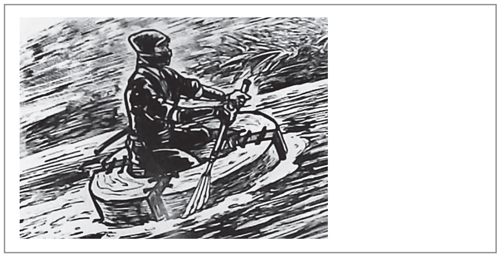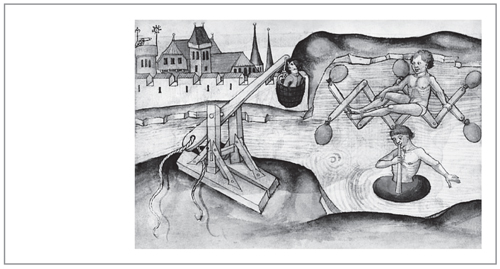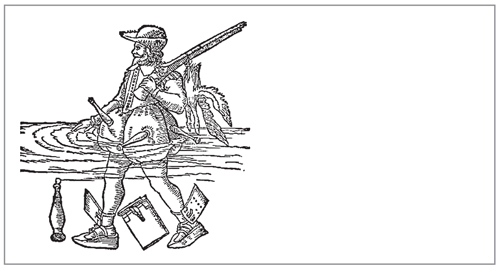Read In Search of the Niinja Online
Authors: Antony Cummins
In Search of the Niinja (28 page)
The middle platform is made of leather and is used as a seat. The ninja puts his legs on either side and uses wooden flippers to propel himself forward. The whole apparatus is leather-covered, sealed and collapsible. Interestingly, the Momochi ‘ninja house’ of Koka has been displaying this information for many years, yet the tool’s proper use continues to be ignored.
In 1963 the researcher Mr Okuse claimed that the tool is borrowed from the Chinese document the
Bubishi
, yet fails to mention that the
Bansenshukai
shows an alternative version and that other scrolls, including the
Shinobi Hiden,
show examples of flotation devices that anchor at the waist. We see the same mistake in the 1959 book
Hidden Ninjutsu
, which appears to stem from the original mistake made in a 1936 publication by Fujita Seiko, where he shows his attempt to use these ‘shoes’ – and claims they do not work! Fujita Seiko claimed to be the inheritor of the last line of Koka ninjutsu (amongst other people). His mistake was probably based on the mention of ‘water shoes’ in several manuals, tools similar to the Water Spider which are in fact lifejackets.

The Water Spider float from the
Ohara
version of the
Bansenshukai
kept in the National Archives.

The display at the Momochi ninja house.

This image of the Water Spider in action is a depiction given by the late ninja researcher Yumio Nawa, a contemporary of Fujita Seiko. Unlike Seiko, he described the Water Spider correctly.

A fifteenth-century German version of the ninja ‘Water Spider’ floating seat.

Daniel Schwenter’s ‘Water Spider’.
The ‘Water Spider’ tool was also a concept of western medieval warfare. The German fight master Hans Talhoffer, who was influenced by the war manual
Bellifortis
written by Konrad Kyeser, shows a version of the floating ring.
Apparently,
85
Daniel Schwenter, the seventeenth-century German mathematician, claimed to have seen a version of this tool in action and recorded it in his
Deliciae Physico-Mathematicae.
Notice (previous page) the identical use of fins attached to the feet or legs which have a one-way hinge, a system reminiscent of the
Bansenshukai
‘flippers’.
One often overlooked part of ninjutsu is the art of the shinobi on open water. Whilst not a central theme to
shinobi no jutsu
there is evidence of the use of ninja during naval battles.
As discussed at the start of this book, simply having the term shinobi in a title does not make the object a ninja or ninja-related.
The Warship Account
manual talks of how to use a ‘shinobi-ship’ and states that a boat should be rigged in the form of a merchant or fishing vessel and made to go amongst the enemy ships, listening to conversations, noting orders and flag commands, and basically doing everything a shinobi would do on land. It talks of stealth and infiltration amongst enemy shipping lines, which most probably was undertaken at night and with the aim of arson.

A section from a Nojima family document which warns of
shinobi no mono
when at sea, presumably concerning their boarding and setting fire to ships.

If the lord of the enemy castle is inexperienced, try to goad and lure them out of the castle, so that you can follow them secretly back into the fortress [when they retreat].
Medieval War Poem
The
Onmitsuhiji shinobi-dai
ninja manual states: ‘Make sure no one gets mixed in with your squad.’ One major task of the shinobi was to conduct, or at least lead, night attacks on enemy encampments. A constant game of cat and mouse was being played, as shinobi from the enemy side tried to infiltrate the attacking force, with the intention of joining their night raid squads so that when the attack was over they could return with the raiders and be guided directly into their encampment. Each army had methods to keep enemy shinobi out, from passwords to ribbons on helmets, even identification by underwear.
No-man’s-land between two encamped samurai armies was a hive of night-time activity, where scouts would fight and blockades and alarm relay systems were set in motion. Feints and repeated night attacks would be mounted to wear down the enemy morale. The fake night raids would be conducted with the intent of drawing enemy shinobi into their group to lead them to a naturally fortified area where they could be butchered. Fire signals, flares, explosions and musical instruments would fill the night air with secret signals.
The
shinobi had two main categories of walking; those that disguise one’s own natural walk and sound of one’s footsteps, such as walking as a cripple, and stealth walks, the art of walking quietly when infiltrating. The latter is of course simply the art of ‘tip-toeing’ with subtle variations. However, the ninja researcher Steven Nojiri has put forward a theory concernig the steps presented in the
Bansenshukai
manual and he believes that the ‘four steps’ written by Fujibayashi represent the stages of infiltration into a building. The four steps of the
Bansenshukai
:
1
Nukiashi,
or steps where the toe is pulled directly out of water and vertical. Alongside this and used as an alternative, Fujibayashi says use ‘Board Shoes’ for marshy areas. These board shoes are square sections of wood akin to snow shoes.
2
Ukiashi
or light and swift footsteps, these should be nimble, like a dog running or a monkey swinging through the trees.
3 The ‘Rabbit Steps’ (discussed below) or ‘Secret Silent Sandals’: this is for walking through house interiors, along corridors and on wooden floored areas.
4 Walking and probing the room with a sword. When in an enemy room the sword is held out in front in the scabbard with only three to six
86
centimetres of the blade out of the scabbard to form a temporary probe.
Nojiri proposes that these four walks actually represent the stages that a ninja would have to go through to infiltrate a house.
A ninja would approach a house through the marshy area outside the walls, probably through rice paddies or even a moat. Here the ninja uses
Nukiashi
or steps where he pulls the foot out of the water vertically to avoid a splashing sound. Or he uses board-like sandals as worn by farmers in marshy areas.
After crossing the marshy area outside of a house the ninja climbs the outer wall and now finds himself between the wall and an open area of land, which he has to cross to get to the house. Here a ninja uses
Ukiashi
or speed running, which is light and darting.
Once the ninja has broken into the house, he walks along the outer wooden platforms or inner corridors of the building, using padded sandals, rabbit fur or a specialised form of walking to creep around the edges of the house in silence.
Having moved around the outer sections of the house, the ninja finds the required room he is searching for and gains entrance. It is here he pulls out his sword and points it in front of him, checking for people and objects in the dark.
